DODGEgallery
|
|
|
|
| Dave Cole, The Music Box, 2012, Caterpillar CS-553 Vibratory Roller-Compacter with cherry wood, spring steel and United States National Anthem (arranged for steamroller), 11 x 19 x 8 feet |
|
Dave Cole, 2012, installation view. Photo: Carly Gaebe

|
Dave Cole, 2012, installation view. Photo: Carly Gaebe
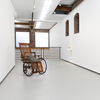
| |
Dave Cole, 2012, installation view. Photo: Carly Gaebe

|
Dave Cole, 2012, installation view. Photo: Carly Gaebe
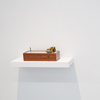
| |
Dave Cole, The Music Box, 2012, installation view. Photo: Carly Gaebe
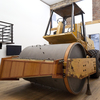
|
Dave Cole, The Music Box, 2012, installation view, detail. Photo: Carly Gaebe
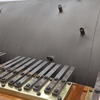
| |
Dave Cole, Singer, 2012, singer industrial sewing machine, teletype paper, wireless internet connection, 39 x 48 x 21 inches. Photo: Carly Gaebe

|
Dave Cole, Singer, 2012, singer industrial sewing machine, teletype paper, wireless internet connection, 39 x 48 x 21 inches, detail. Photo: Carly Gaebe
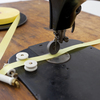
| |
Dave Cole, American Flag (Lead), 2012, lead sheet and stainless steel cable, hand sewn, 45 x 84 x 3 inches. Photo: Carly Gaebe
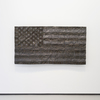
|
Dave Cole, American Flag (Lead), 2012, lead sheet and stainless steel cable, hand sewn, 45 x 84 x 3 inches, detail. Photo: Stewart Clements Photography
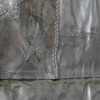
| |
Dave Cole, Song-Books of The War, 2012, mixed media with invalid chair, 20,000 buffalo nickels, 49.75 x 26 x 43 inches. Photo: Stewart Clements Photography
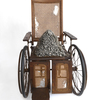
|

| |
Dave Cole, Three Generations, 2012, hand-turned hardwood with sterling silver, 8 x 2 x 2, 7 x 2 x 2, 5.5 x 2.25 x 2.5 inches. Photo: Carly Gaebe
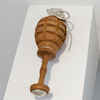
|
Dave Cole, Belt Plate (after Antietam), 2012, cast lead from melted bullets and recycled lead type, 1.5 x 16 x 10 inches. Photo: Stewart Clements Photography
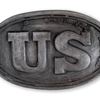
|
|
| Sculpture Magazine, "New York, Dave Cole" - Jan Garden Castro |
 DOWNLOAD DOWNLOAD | | Modern Painters, "Dave Cole" - Orit Gat |
 DOWNLOAD DOWNLOAD | | This Week in New York, "Dave Cole" - Mark Rifkin |
| READ ONLINE | | Art in America, ''The Lookout: A Weekly Guide to Shows You Won't Want to Miss'' - Leigh Anne Miller |
READ ONLINE  DOWNLOAD DOWNLOAD |
|
|
|
|
|
|
DAVE COLE
|
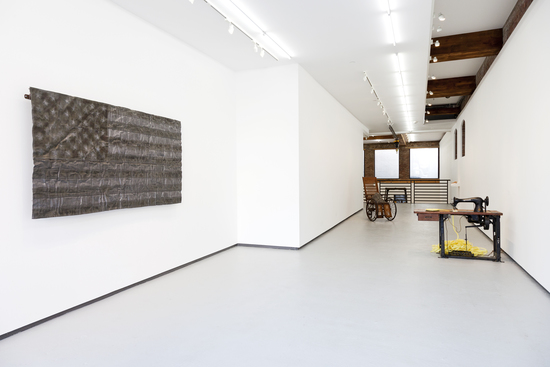
|
| IMAGE: Dave Cole, 2012, installation view. Photo: Carly Gaebe |
 HI-RES HI-RES |  |
 |
|
On View: September 8 — October 28, 2012
Reception: September 8, 2012 6-8pm |
 DOWNLOAD PRESS RELEASE AS PDF DOWNLOAD PRESS RELEASE AS PDF
| DODGEgallery is pleased to present Dave Cole’s second solo exhibition at the gallery.
In his most recent body of work, Cole navigates memory, history, national identity and the interlocking resonance of each. Cole’s protean craftsmanship gives voice to both a scholarly knowledge of this nation’s past and a conscientious understanding of what it means to be an American today. His work is a poetic inquisition into the path of empire; it is also a silver-lined bow to the impartial course of time. The work gives ear to the inevitable and often tragic march of history, played to a tune of desire, longing, and hope. In his second solo exhibition at DODGEgallery, Cole is presenting six new works, including one of monumental scale.
The centerpiece of the show is Cole's The Music Box. In partnership with Ohio CAT, and the Cleveland Institute of Art—who commissioned the piece earlier this year—Cole has fabricated a functional music box driven by a full-size Vibratory Roller-Compactor (a steamroller). The 22,000 lb machine was donated by Ohio CAT for Cole to dismantle and re-fabricate. Cole, leading a team of fabricators, machinists, musicians and mechanics recreated over 80% of the machine—seemingly identical to the original, but mobile, musical, and at a tiny fraction of the original weight. The front of the machine supports the wooden acoustical cabinet, which Cole built from Cherry wood harvested from his family farm in New Hampshire. The steady, slow roll of the drum plays The Star Spangled Banner, with the voice of a mechanical Juggernaut. The deep, loud, gut-wrenching clatter is akin to memory—recalling something familiar but distant. The viewer’s rote memory of the song plays in conjunction with Cole’s haunting version. Taking an intimate, child-like form of something that is turned by hand, Cole presents a music box that is gargantuan in comparison, akin to what only dreams can manifest. Any anthem is martial music, and Cole presents his with both the tenderness of faded memories, and the brutality of a crushing machine.
As quiet and contemplative as the The Music Box is loud and aggressive, Cole's American Flag (Lead) speaks the vocabulary of textiles with the voice of heavy industry. The piece was fabricated with Cole's typical obsessive craftsmanship—sheets of lead treated as though they were bolts of cloth: cut and stitched by hand with braided cables of stainless steel wire finer than human hair. This is Cole’s most laborious flag series to date; even after being punched by machine (a modified industrial sewing machine) all of the stripes and every star had to be re-routed with a tiny drill, and then double-stitched by hand— each hour of physically demanding labor yielding less than eight linear inches of stitching. The result is a broad, undulating object that transcends its materiality; the lead appears more like a worn leather or heavy fabric than metal. The malleable and wrinkled form takes on the appearance of something soft that has been frozen in time, and the lack of color makes the image that it creates seem more like an afterimage of a flag than the thing itself. The familiar red, white and blue flickers over the presence of the toned grays, oscillating memory with the present object. Importantly, Cole’s flags are not only representations of the American flag, they are also scaled to government standard proportions and therefore are an actual flag of the United States. Cole is both carefully creating objects that are of our nation, and flags that transcend specificity, eliciting questions of what place the flag held and holds in our consciousness.
Other works in the exhibition include Song-Books of The War, Belt Plate (after Antietam), Three Generations, and Singer. In Song-Books of The War, Cole combines a wooden and wicker “Invalid Chair”, with a mountainous stack of Buffalo Nickels—the quintessential (and quintessentially American) 'small change' of the interwar years. The scale of the stack is determined by the weight of the artist; a body mass made up of a low currency now long out of circulation. Titled for the Siegfried Sassoon poem of the same name, Song-Books of The War is a meditation on the massive nature of man's violent inclinations, the somber silence of the consequences, and our perennial willingness to march toward violence again.
To make Belt Plate (after Antietam) Cole melted down and cast a vast quantity of both lead bullets and lead type to create a Civil War belt buckle on the scale of a prize-fighters belt. A once ubiquitous artifact, lifted from history, and recreated with weapons of war. By turns pedestrian, horrific, and monumental (Antietam remains the bloodiest day in American history—23,000 casualties in twelve hours) Belt Plate (after Antietam) stands proxy for 150 years of historiographic triumphalism.
The most intimate works in the show, Three Generations, consist of a group of hardwood and sterling silver baby rattles—in the form of the three hand grenades used by the US Army in WWII, Vietnam, and the current ongoing wars—the baby boom, the baby boomers, and the baby boomers kids. It is a disturbing and cross-bred fetishization of history, child-rearing, and violence.
Finally, Singer is just that—a Singer industrial sewing machine made in the fall of 1920 in Elizabeth New Jersey—apparently operating itself. The simple animatronic trick is, in fact, a Herculean feat (at least for a 92 year old sewing machine). The machine is searching the internet, repeating strings of queries related to its own operation and then “printing” the results into a binary code by altering the rate at which it feeds contemporaneous teletype paper under its needle. It is an expression of monumental accomplishment accomplishing nothing: “The Modernist Crisis”, seen through the eyes of a solitary sewing machine.
Special thanks to Ohio CAT and The Cleveland Institute of Art; without their generous support The Music Box would not have been possible. |
|
|
| |
|
|
|
| |
|
|